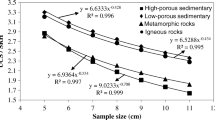Abstract
The Schmidt hammer test is a non-destructive method which can be used in both laboratory and field to provide a quick and relatively inexpensive measure of rock hardness. The study investigated the relationship between the Schmidt hardness and modulus of elasticity, uniaxial compressive strength and index properties of nine types of rock including travertine, limestone, dolomitic limestone and schist. The empirical equations developed indicated the Schmidt hardness rebound values have a reliable relationship with the uniaxial compressive strength of rock (r = 0.92). Comparing the results with those reported by other researchers, it is concluded that no single relationship can be considered reliable for all rock types. Whilst the equations developed in this study may be useful at a preliminary stage of design, they should be used with caution and only for the specified rock types.
Résumé
Le test au marteau de Schmidt est une méthode non-destructive qui peut être utilisée au laboratoire ou sur le terrain afin de fournir une mesure rapide et relativement peu coûteuse de la dureté d’une roche. L’étude a concerné la recherche de relations entre la dureté de Schmidt et le module d’élasticité, la résistance à la compression uniaxiale et divers indices géotechniques pour neuf types de roches (travertins, calcaires, calcaires dolomitiques, et schistes). Les équations empiriques établies indiquent que les valeurs de rebond obtenues au marteau de Schmidt sont corrélées de façon fiable avec la résistance à la compression uniaxiale de la roche (r = 0,92). Comparant ces résultats avec ceux obtenus par d’autres chercheurs, on peut conclure qu’il n’est pas possible de retenir une seule relation pour tous les types de roches. Tandis que les équations présentées dans cette étude peuvent être utiles dans des étapes préliminaires de conception, elles devraient être utilisées avec prudence et seulement pour des types de roches spécifiques.













Similar content being viewed by others
References
Aufmuth RE (1973) A systematic determination of engineering criteria for rocks. Bull Assoc Eng Geol 11:235–245
Aydin A, Basu A (2005) The Schmidt hammer in rock material characterization. Eng Geol 81:1–14
Barton N, Choubey V (1977) The shear strength of rock joints in theory and practice. Rock Mech 10:1–54
Beverly BE, Schoenwolf DA, Brierly GS (1979) Correlations of rock index values with engineering properties and the classification of intact rock. Brierley Associates, Washington
Cargill JS, Shakoor A (1990) Evaluation of empirical methods for measuring the uniaxial compressive strength. Int J Rock Mech Min Sci 27:495–503
Deere DU, Miller RP (1966) Engineering classification and index properties for intact rocks. Tech Report. Air Force Weapons Lab., New Mexico, No. AFNL-TR, Kirtland, pp 65–116
Ghose AK, Chakraborti S (1986) Empirical strength indices of Indian coals—an investigation. In: Proc 27th US Symp. on rock mech, Balkema, Rotterdam, pp 59–61
Gokceoglu C (1996) Schmidt sertlik cekici kullanılarak tahmin edilen tek eksenli basınc dayanımı verilerinin guvenirliligi uzerine bir degerlendirme. Jeol Muhendis 48:78–81 (in Turkish)
Haramy KY, DeMarco MJ (1985) Use of Schmidt hammer for rock and coal testing. In: Proc 26th US symp. on rock mech, 26–28 June, Rapid City, Balkema, Rotterdam, pp 549–555
ISRM (1981) Rock characterization testing and monitoring, ISRM Suggested Methods. International Society for Rock Mechanics, 211 pp
Kahraman S (2001) Evaluation of simple methods for assessing the uniaxial compressive strength of rock. Int J Rock Mech Min Sci 38:981–994
Katz O, Reches Z, Roegiers JC (2000) Evaluation of mechanical rock properties using a Schmidt hammer. Int J Rock Mech Min Sci 37:723–728
Kidybinski A (1980) Bursting liability indices of coal. Int J Rock Mech Min Sci Geomech Abstr 17:167–171
O’Rourke JE (1989) Rock index properties for geoengineering in underground development. Min Eng 41(2):106–110
Schmidt E (1951) A non-destructive concrete tester. Concrete 59(8):34–35
Shalabi F, Cording EJ, Al-Hattamleh OH (2007) Estimation of rock engineering properties using hardness tests. Eng Geol 90:138–147
Sachpazis CI (1990) Correlating Schmidt hardness with compressive strength and Young’s modulus of carbonate rocks. Bull Int Assoc Eng Geol 42:75–83
Shorey PR, Barat D, Das MN, Mukherjee KP, Singh B (1984) Schmidt hammer rebound data for estimation of large scale in situ coal strength. Int J Rock Mech Min Sci Geomech Abstr 21:39–42
Singh RN, Hassani FP, Elkington PAS (1983) The application of strength and deformation index testing to the stability assessment of Coal Measures excavations. In: Proc. 24th US symp. on rock mech, Texas A and M Univ. AEG, Balkema, Rotterdam, pp 599–609
SPSS (2002) Statistical package for the social sciences. Data analysis software packages. Version 11.5. SPSS Inc., Chicago
TS 699 (1987) Methods of testing for natural buildings stones. Institute of Turkish Standards
Xu S, Grasso P, Mahtab A (1990) Use of Schmidt hammer for estimating mechanical properties of weak rock. In: Proc. 6th international IAEG congress, vol 1, Balkema, Rotterdam, pp 511–519
Yasar E, Erdogan Y (2004) Estimation of rock physiomechanical properties using hardness methods. Eng Geol 71:281–288
Yilmaz I, Sendir H (2002) Correlation of Schmidt hardness with unconfined compressive strength and Young’s modulus in gypsum from Sivas (Turkey). Eng Geol 66:211–219
Acknowledgments
The author thanks to the Research Fund of the Pamukkale University for the financial support. Project Number: 2006/MHF-004. The author would like to express his appreciation to Komurcuoglu Travertine Company in Denizli for their friendship and logistic support during field works. Also, special thanks to Dr. Candan Gokceoglu from Hacettepe University for his valuable suggestions on the manuscript.
Author information
Authors and Affiliations
Corresponding author
Rights and permissions
About this article
Cite this article
Yagiz, S. Predicting uniaxial compressive strength, modulus of elasticity and index properties of rocks using the Schmidt hammer. Bull Eng Geol Environ 68, 55–63 (2009). https://doi.org/10.1007/s10064-008-0172-z
Received:
Accepted:
Published:
Issue Date:
DOI: https://doi.org/10.1007/s10064-008-0172-z




